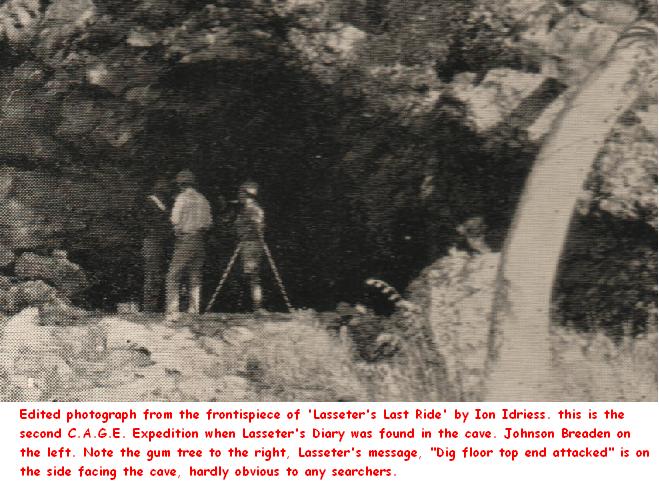34. BREADEN, Allan and Johnson. |
| "At Buck's place they met a man named Breaden, who remembered a young chap named Bell out in those parts thirty years ago" . |
|
Errol Coote, Hell's Airport. Page 225. Allan Breaden, a long time Centralian pastoralist and explorer was residing at Bob Buck's station, Middleton Ponds, when Philip Taylor arrived there on his way to Ayers Rock. Taylor's mission was to set up a base camp at the 'Rock for Errol Coote, who intended to carry out an ariel search for Lasseter. Taylor sought refuge at Buck's station from the drought breaking rains that inundated Central Australia at the end of October 1930. He could not carry on until the camel packs and equipment had dried out, apparently taking four days to do so. That would have been an enlightening four days for Taylor, during which he met Buck's uncle, who remembered a "young chap named Bell out in those parts thirty years ago. He was making his way through to the west coast". Coote, who recorded Breaden's recollection third hand through Taylor, concluded that as Bell was one of Lasseter's names, having served in the army under that name, then Breaden's 'Bell' must be Lasseter, and the story of his reef must be true. Coote writes as if these conclusions are Taylor's, but the canny young driver and engineer had long ago dismissed Lasseter as an old humbug. Allan Breaden's recollections have been mistakenly attributed to his son, Johnson Breaden, Bob Buck's first cousin. Johnson, who was younger than Taylor, would not be in a position to recall who passed through the Outback thirty years ago, but he did have a peripheral involvement in the Lasseter saga. Johnson, who was part Aboriginal, and Buck's right hand man, accompanied his cousin on the second C.A.G.E. expedition, and one of the few photographs extent shows Johnson to the left of a group of men at the entrance to Lasseter's cave when Lasseter's diary was found, Johnson's trade mark white kerchief showing clearly. Johnson was also on Buck's expedition in search for Lasseter, and according to Walter Gill, as told by Buck, it was Johnson who first heard from the Aboriginals details of Lasseter's fate. During May 1931, within a month of Buck's return from his search for Lasseter, Gill was travelling with Buck, Breaden and Billy Buttons to the Petermann Ranges in search of a little known Aboriginal tribe, and Gill wrote very detailed descriptions of his companions. Of Johnson he wrote, "when he was speaking in Arundta or Pidjandjarra, he gave the impression of being wholly and contentedly native. I like Johnson. Given half a chance, I think he will come to accept me". Gill was somewhat less generous regarding Buck. The following year Allan Breaden met another English, 'new come up' as new chums to the outback were called, in this case the adventurous and competent Michael Terry, who was on his way west to fill in gaps in the maps and to eliminate more of central Australia as gold bearing. Breaden senior gave Terry a warning, "If you ever get anywhere near Sladen Waters, look out; douse your fire early and camp in the open. Don't trust those Rawlinson blacks--they've done in Hansen and Smith somewhere near Sladen Waters--I'm sure of it. The boy who told me isn't given to repeating idle yarns". In this case Breaden was referring to Lasseter's mate, Johanson, who failed to rendezvous with Lasseter at Lake Christopher. And given that Lasseter did not start using the name Bell until 1925, two years after Harold Bell Wright published his minor classic about a lost gold mine, it would seem Breaden suffered from selective or induced memory, depending on who was recording his recollections. Perhaps Bob Buck's proclivity for tall stories was an inherited condition.
© R.Ross. 1999-2006 |
| Coote, Errol. Hell's Airport. 225. Gill, Walter. Petermann Journey. 10, 25. Terry, Michael. Sun and Sand. 153-154. |

